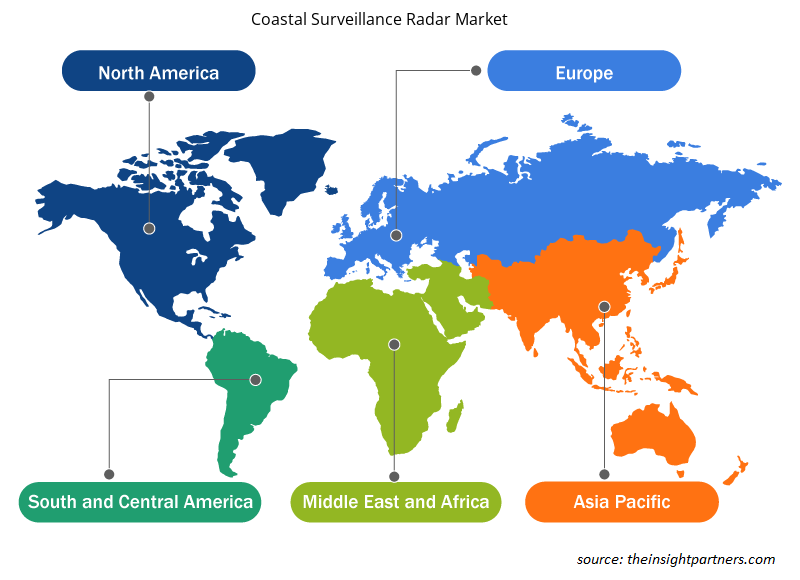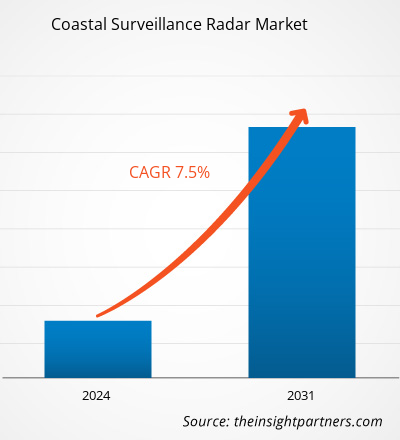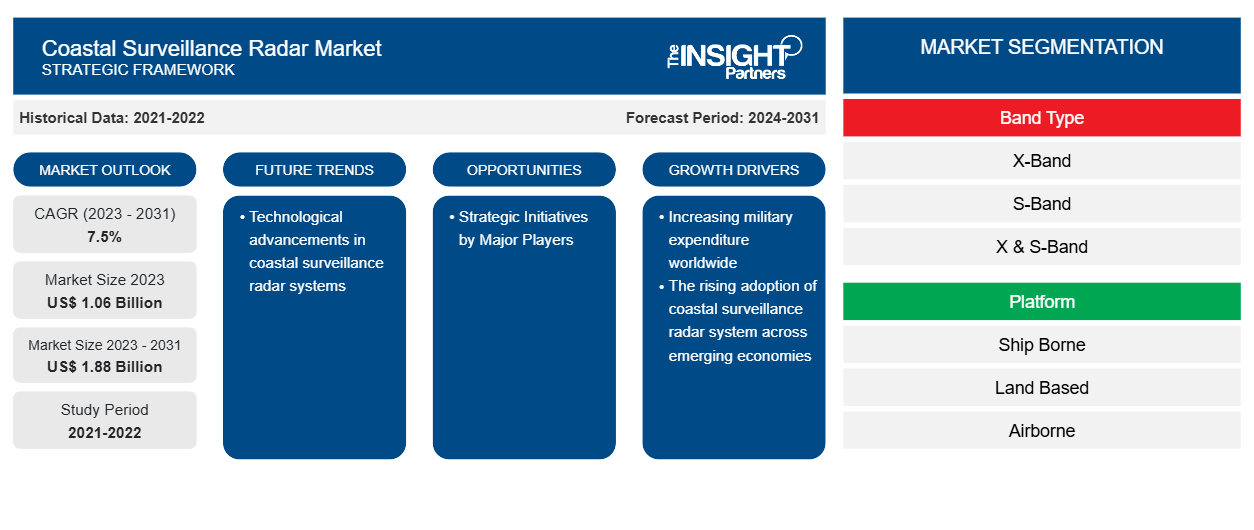Der Markt für Küstenüberwachungsradare soll von 1,06 Milliarden US-Dollar im Jahr 2023 auf 1,88 Milliarden US-Dollar im Jahr 2031 anwachsen. Der Markt soll zwischen 2023 und 2031 eine durchschnittliche jährliche Wachstumsrate von 7,5 % verzeichnen. Der technologische Fortschritt bei Küstenüberwachungsradarsystemen dürfte ein wichtiger Trend auf dem Markt bleiben.
Marktanalyse für Küstenüberwachungsradare
Elbit Systems Ltd, Thales Group, Israel Aerospace Industries, Hensoldt AG und Terma A/S sind einige der wichtigsten Marktteilnehmer auf dem globalen Markt für Radargeräte zur Küstenüberwachung. Diese Unternehmen entwickeln robuste Systeme, darunter X-Band-, S-Band- und X- und S-Band-Radare für verschiedene Endnutzer. Darüber hinaus haben diese Unternehmen auch zahlreiche Verträge für ihre Radargeräte von verschiedenen Seestreitkräften, Küstenwachen, Öl- und Gasunternehmen sowie Häfen erhalten. Die Unternehmen schließen langfristige Verträge mit den Endnutzern ab, um die Versorgung mit Radargeräten zur Küstenüberwachung zu unterstützen, wodurch die Unternehmen Jahr für Jahr Umsatz erzielen können.
Marktübersicht für Küstenüberwachungsradare
Zu den wichtigsten Akteuren im globalen Ökosystem des Küstenüberwachungsradarmarkts gehören unter anderem Komponentenhersteller, Systemintegratoren und Endnutzer. Ein Küstenüberwachungssystemradar besteht aus verschiedenen Komponenten, die von den Systemherstellern von einer riesigen Basis von Komponentenherstellern beschafft werden. Diese Komponentenhersteller liefern die Basisteile an die globalen Akteure im Bereich Küstenüberwachungsradar. Die Systemintegratoren sind die Unternehmen, die nach der Integration jeder Komponente mit der Herstellung der endgültigen Überwachungsradarsysteme beschäftigt sind. Zu den Endnutzern des globalen Küstenüberwachungsradarmarkts gehören sowohl Regierungsstellen als auch private Organisationen, die an der Küste Geschäfte machen. Die multinationalen Öl- und Gasunternehmen an den Küsten sind in hohem Maße von Überwachungsradaren abhängig, um die Sicherheit ihres Betriebs und ihrer Vermögenswerte zu gewährleisten. Andererseits treiben auch die steigenden Militärausgaben der Industrie- und Entwicklungsländer und ihre steigenden Investitionen zum Schutz der Land- und Küstengrenzen vor Faktoren wie Drogenhandel, Terror und illegalen Einwanderern unter anderem die starke Einführung von Küstenüberwachungsradaren durch die Regierungsstellen voran.
Passen Sie diesen Bericht Ihren Anforderungen an
Sie erhalten kostenlos individuelle Anpassungen an jedem Bericht, einschließlich Teilen dieses Berichts oder einer Analyse auf Länderebene, eines Excel-Datenpakets sowie tolle Angebote und Rabatte für Start-ups und Universitäten.
-
Holen Sie sich die wichtigsten Markttrends aus diesem Bericht.Dieses KOSTENLOSE Beispiel umfasst eine Datenanalyse von Markttrends bis hin zu Schätzungen und Prognosen.
Treiber und Chancen des Küstenüberwachungsradars
Steigende Verbreitung von Radarsystemen zur Küstenüberwachung in Schwellenländern
Die zunehmenden Bedrohungen der Grenzen in Schwellenländern wie China, Indien, Taiwan, Südkorea, Russland, der Ukraine, Israel, Palästina und dem Iran dürften die Einführung von Radarsystemen zur Küstenüberwachung vorantreiben. Aufgrund der Zunahme von Seekriegen und Aufständen auf dem Meer werden die Küstenregionen in diesen Volkswirtschaften immer wichtiger, und Überwachungsradare spielen eine entscheidende Rolle bei der Erkennung von Bedrohungen in Echtzeit. Kommandeure können durch den Einsatz moderner Radarsysteme entlang der Küstengrenzen wertvolle Einblicke in die Bewegungen des Feindes und seine Umgebung gewinnen und so auf der Grundlage von Echtzeitdaten die erforderlichen Maßnahmen ergreifen. Dieser Vorteil der Erfassung von Echtzeitdaten mit klaren und hochauflösenden Bildern ist der entscheidende Anziehungspunkt für die Endbenutzer. Aufgrund dieser entscheidenden Parameter wächst der Markt für Radarsysteme zur Küstenüberwachung weltweit.
Strategische Initiativen wichtiger Akteure
Die auf dem Markt für Küstenüberwachungsradare tätigen Unternehmen verfolgen organische und anorganische Wachstumsstrategien, wie hohe Investitionen, Produktangebote und globale Expansion, und schaffen so weitere Wachstumschancen für den globalen Markt für Küstenüberwachungsradare. Einige wichtige Entwicklungen sind zu nennen:
- Im September 2022 vergab die US-Küstenwache einen Auftrag an L3Harris Technologies Inc. für bis zu fünf AN/APY-11-Multimode-Radare, die während der Minotaur-Missionierung auf neuen Langstreckenüberwachungsflugzeugen des Typs C-130J Super Hercules installiert werden sollen. Der Festpreisvertrag umfasst die Lieferung von drei Multimode-Radaren, die von L-3 Communication Integrated Systems in Waco, Texas, während der Missionierung und des Block 8.1-Upgrades für das 18., 19. und 20. C-130J-Flugzeug der Küstenwacheflotte installiert werden.
- Im Dezember 2022 unterzeichnete LIG Nex1 Co eine Vereinbarung mit dem Naval Logistics Command für das Projekt Maritime Surveillance Radar-II.
Solche Entwicklungen haben für Marktanbieter in verschiedenen Regionen neue Chancen geschaffen.
Segmentierungsanalyse des Marktberichts zum Küstenüberwachungsradar
Wichtige Segmente, die zur Ableitung der Marktanalyse für Küstenüberwachungsradare beigetragen haben, sind Bandtyp, Plattform und Endbenutzer.
- Basierend auf dem Bandtyp ist der Markt für Küstenüberwachungsradare in X-Band, S-Band, X/S-Band und andere unterteilt. Das X-Band-Segment hatte im Jahr 2023 einen größeren Marktanteil.
- Basierend auf der Plattform ist der Markt für Küstenüberwachungsradare in Schiffs-, Land- und Luftradare segmentiert. Das Luftradarsegment hatte im Jahr 2023 einen größeren Marktanteil.
- Basierend auf dem Endnutzer ist der Markt für Küstenüberwachungsradare in Häfen, Öl- und Gasunternehmen und Seepatrouillenagenturen segmentiert . Das Segment der Seepatrouillenagenturen hatte im Jahr 2023 einen größeren Marktanteil.
Küstenüberwachungsradar Marktanteilsanalyse nach Geografie
Der geografische Umfang des Marktberichts zum Küstenüberwachungsradar ist hauptsächlich in fünf Regionen unterteilt: Nordamerika, Europa, Asien-Pazifik, Naher Osten und Afrika sowie Südamerika.
Nordamerika hat den Markt im Jahr 2023 dominiert, gefolgt von Europa und dem asiatisch-pazifischen Raum. Darüber hinaus wird der asiatisch-pazifische Raum in den kommenden Jahren wahrscheinlich auch die höchste durchschnittliche jährliche Wachstumsrate verzeichnen. Die USA hatten den größten Marktanteil auf dem nordamerikanischen Markt für Küstenüberwachungsradare. Die USA sind auch ein technologisch fortschrittliches Land und haben ein enormes Potenzial, im Laufe der Jahre neue Technologien einzuführen. Die im ganzen Land vertretenen Öl- und Gasunternehmen haben ebenfalls ein enormes Potenzial, Technologien zur Sicherung ihres Betriebs an den Küsten einzuführen. Dies beeinflusst den Einsatz von Küstenüberwachungsradaren weiter, um illegale Aktivitäten im ganzen Land einzuschränken oder zu begrenzen. Accipiter Radar Technologies Inc, Teledyne FLIR LLC, L3Harris Technologies Inc, Raytheon Technologies Corporation und SSR Engineering sind einige der Akteure, die auf dem US-Markt tätig sind.
Regionale Einblicke in den Markt für Küstenüberwachungsradare
Die regionalen Trends und Faktoren, die den Markt für Küstenüberwachungsradare im Prognosezeitraum beeinflussen, wurden von den Analysten von Insight Partners ausführlich erläutert. In diesem Abschnitt werden auch die Marktsegmente und die Geografie von Küstenüberwachungsradaren in Nordamerika, Europa, im asiatisch-pazifischen Raum, im Nahen Osten und Afrika sowie in Süd- und Mittelamerika erörtert.

- Erhalten Sie regionale Daten zum Markt für Küstenüberwachungsradare
Umfang des Marktberichts zum Küstenüberwachungsradar
| Berichtsattribut | Details |
|---|---|
| Marktgröße im Jahr 2023 | 1,06 Milliarden US-Dollar |
| Marktgröße bis 2031 | 1,88 Milliarden US-Dollar |
| Globale CAGR (2023 - 2031) | 7,5 % |
| Historische Daten | 2021-2022 |
| Prognosezeitraum | 2024–2031 |
| Abgedeckte Segmente |
Nach Bandtyp
|
| Abgedeckte Regionen und Länder |
Nordamerika
|
| Marktführer und wichtige Unternehmensprofile |
|
Marktteilnehmerdichte für Küstenüberwachungsradare: Auswirkungen auf die Geschäftsdynamik verstehen
Der Markt für Küstenüberwachungsradare wächst rasant, angetrieben durch die steigende Endverbrauchernachfrage aufgrund von Faktoren wie sich entwickelnden Verbraucherpräferenzen, technologischen Fortschritten und einem größeren Bewusstsein für die Vorteile des Produkts. Mit steigender Nachfrage erweitern Unternehmen ihr Angebot, entwickeln Innovationen, um die Bedürfnisse der Verbraucher zu erfüllen, und nutzen neue Trends, was das Marktwachstum weiter ankurbelt.
Die Marktteilnehmerdichte bezieht sich auf die Verteilung der Firmen oder Unternehmen, die in einem bestimmten Markt oder einer bestimmten Branche tätig sind. Sie gibt an, wie viele Wettbewerber (Marktteilnehmer) in einem bestimmten Marktraum im Verhältnis zu seiner Größe oder seinem gesamten Marktwert präsent sind.
Die wichtigsten auf dem Markt für Küstenüberwachungsradare tätigen Unternehmen sind:
- Accipiter Radar Technologies Inc
- Aselsan AS
- Blighter Surveillance Systems Ltd
- Easat Radar Systems Ltd
- Elbit Systems GmbH
- Teledyne FLIR LLC
Haftungsausschluss : Die oben aufgeführten Unternehmen sind nicht in einer bestimmten Reihenfolge aufgeführt.

- Überblick über die wichtigsten Akteure auf dem Markt für Küstenüberwachungsradare
Nachrichten und aktuelle Entwicklungen zum Küstenüberwachungsradarmarkt
Der Markt für Küstenüberwachungsradare wird durch die Erhebung qualitativer und quantitativer Daten nach Primär- und Sekundärforschung bewertet, die wichtige Unternehmensveröffentlichungen, Verbandsdaten und Datenbanken umfasst. Nachfolgend sind einige der Entwicklungen auf dem Markt für Küstenüberwachungsradare aufgeführt:
- Leonardo hat einen Anteil von 30 % am Aktienkapital von GEM elettronica erworben, einem italienischen Unternehmen, das auf die Herstellung kleiner und mittelgroßer 3D-Radare, elektrooptischer Sensoren und Trägheitssysteme für den See-, Luft- und Landsektor spezialisiert ist. (Quelle: Leonardo, Pressemitteilung, April 2021)
- Der Sensorlösungsanbieter HENSOLDT rüstet den National Security Cutter (NSC) der „Legend“-Klasse der US-Küstenwache mit seinem bewährten Multimode-Marineradar TRS-3D aus. Die US-Küstenwache erteilte HENSOLDT einen Folgeauftrag im Wert von rund 10 Mio. $ für die Lieferung eines weiteren Radars in seiner neuesten Version „Baseline D“, das im Trainingszentrum der Küstenwache (TRACEN) in Petaluma/CA installiert werden soll. Bisher hat HENSOLDT 12 Radare an das NSC-Programm der US-Küstenwache geliefert. (Quelle: HENSOLDT, Pressemitteilung, September 2023)
Marktbericht zum Küstenüberwachungsradar – Abdeckung und Ergebnisse
Der Bericht „Marktgröße und Prognose für Küstenüberwachungsradar (2021–2031)“ bietet eine detaillierte Analyse des Marktes, die die folgenden Bereiche abdeckt:
- Marktgröße und Prognose für Küstenüberwachungsradare auf globaler, regionaler und Länderebene für alle wichtigen Marktsegmente, die im Rahmen des Berichts abgedeckt sind
- Markttrends und Marktdynamiken für Küstenüberwachungsradare wie Treiber, Beschränkungen und wichtige Chancen
- Detaillierte Porter-Fünf-Kräfte-Analyse
- Marktanalyse für Küstenüberwachungsradare mit wichtigen Markttrends, globalen und regionalen Rahmenbedingungen, wichtigen Akteuren, Vorschriften und aktuellen Marktentwicklungen
- Branchenlandschaft und Wettbewerbsanalyse, einschließlich Marktkonzentration, Heatmap-Analyse, prominenten Akteuren und aktuellen Entwicklungen auf dem Markt für Küstenüberwachungsradare
- Detaillierte Firmenprofile
- Historische Analyse (2 Jahre), Basisjahr, Prognose (7 Jahre) mit CAGR
- PEST- und SWOT-Analyse
- Marktgröße Wert/Volumen – Global, Regional, Land
- Branchen- und Wettbewerbslandschaft
- Excel-Datensatz
Aktuelle Berichte
Verwandte Berichte
Erfahrungsberichte
Grund zum Kauf
- Fundierte Entscheidungsfindung
- Marktdynamik verstehen
- Wettbewerbsanalyse
- Kundeneinblicke
- Marktprognosen
- Risikominimierung
- Strategische Planung
- Investitionsbegründung
- Identifizierung neuer Märkte
- Verbesserung von Marketingstrategien
- Steigerung der Betriebseffizienz
- Anpassung an regulatorische Trends























 Kostenlose Probe anfordern für - Markt für Küstenüberwachungsradare
Kostenlose Probe anfordern für - Markt für Küstenüberwachungsradare